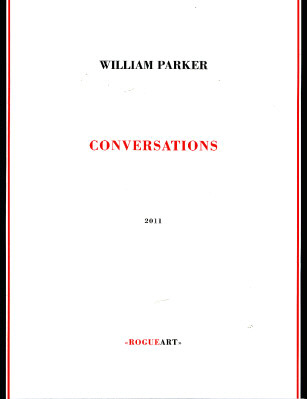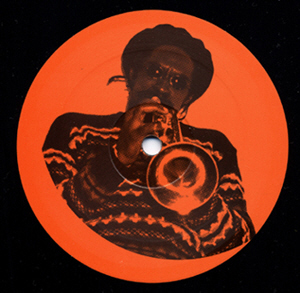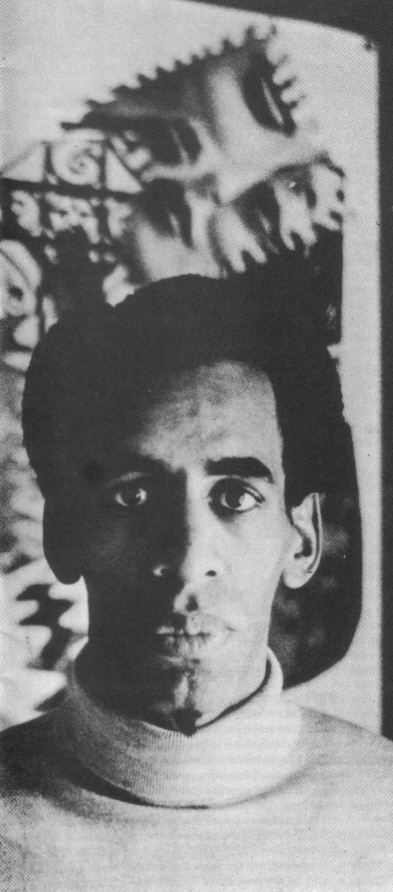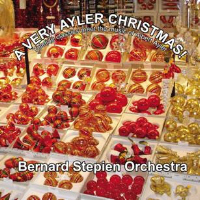|
Music Is The Healing Force Of The Universe The Inconsistency of |
|
|
||||||||||||||||
|
News from 2012 - June to December June 1 2012 William Parker - Conversations |
|
|
|
From the Milford Graves chapter: “I’ve seen in print that Albert Ayler cracked my ceiling in my apartment. That’s inaccurate. That’s bad history. He did not crack my ceiling when I was living in Brooklyn. I was in an old four-family apartment building. Albert came over to my three-room apartment to do some playing. I said, “Let’s go into my playing room.” It was a very small room. So Albert looked around at the ceiling and he took a rag and he stuffed it in his horn. He looked at me and said, “I’m going to put this rag in the opening of my horn, because”—as he was looking up at the worn condition of my ceiling—“I don’t want to crack your ceiling more than what it already is.” And Albert played but Albert didn’t play the same way we did on a lot of gigs. Albert didn’t play a tune. In the end Albert did not further widen the cracks in my ceiling. Albert is an icon in the music and they will play Albert’s music and people will try to play Albert’s stuff and think they’re playing like Albert Ayler. I say, “No, you’re playing relative to Albert Ayler or an adjusted Albert Ayler according to the situation he was in.” He played some tricky melodies; Albert knew the tricky melodies that he was playing would be catchy! He knew to play the French national anthem when it was necessary. But I was there at times when Albert didn’t do that. Albert didn’t play catchy melodies when we were in a parade for the opening of the Black Arts Repertory Theatre/School (BART/S) in Harlem in 1965. The parade started at Lenox Avenue and 130th Street, went down to 125th Street and across to Seventh Avenue, then back along Seventh Avenue to 130th Street and Lenox Avenue where Black Arts Repertory Theatre/School was located. People were on the sidewalks of Harlem, they were looking out their windows! I had a drum tied around my waist. It was Don Ayler, Albert and I. Amiri Baraka [founder of BART/S] in front with two other guys carrying the Black Arts and American flags with a police car escorting us. Sun Ra was behind us with his band. To my knowledge this event was not recorded. I remember one time when we played at the BART/S and it was powerful! It was Albert, Don, I think Henry grimes, Mustafa [Abdul Rahim] and what’s the alto player who died? Charles Tyler? Charles Tyler. There wasn’t no more of that (sings) dah dah dah du du dah dah ... ... you didn’t hear none of that! You did not hear those noted Albert Ayler lines that people were used to hearing. It wasn’t like the Love Cry recording on Impulse records. It was none of that stuff. No, this was something totally different. That was an adaptive music.” * From the Sunny Murray chapter: “Let me see if you remember this, now. Remember we were doing a gig, we did a week at Lush Life? Yeah. It was me, you... Jerome [Cooper]. Curtis Clark, Grachan Moncur... we was in the middle of the gig and Donald Ayler walks in. I’ll keep telling the story and see if I’m making it up or not. (laughs) He walks in and he’s like walking up to the bandstand. Then he turns around and you’re doing something, you make a gesture, and he like leaves. Then he comes back at the intermission with an alto saxophone, playing the alto saxophone in the corner. That’s possible, because that’s where he went, from the trumpet to the alto. That’s what he’s playing now. As I recall, he played the alto saxophone in the corner the whole intermission and then he left. And then he came back after the gig was done and y’all was talkin’. I don’t remember that but I remember the horn and the playin’. Because he came in my house in Brooklyn with that. I hate to say it, but I kind of warned Al. He said, “I’m bringing my younger brother to new York. But my mother don’t want me to do it because he’s the baby.” I was kind of talking against it. Not really against it, but contrary. So finally Albert brought Donnie. Donnie was a great young cat. And I saw this love, this loved one. I said, “Hey man. You can’t let Donnie down, man. He loves you too much. If you let him down, he’s gonna crack like glass.” Albert said, “Oh no, Murray. It couldn’t be about that, Murray.”Okay, so that moment came. It came with Impulse. Impulse didn’t want Donnie and Albert didn’t know how to handle that. Albert started cutting, cutting away a bit. Not with words or fightin’, just he met this girl, Marie. I didn’t even know where Albert disappeared to. Normally me and Albert always keep some connections. We were very close. He wasn’t too far away but I didn’t know where. But for Donnie, it was like his brother disappeared in the ground. he’d look here, he’d look there, people would say this. He’d come over my house. Then he started going out because he came to my house during that period when he was searching, and I was in the toilet and he was ringin’ the bell, hollerin’ my name. It was in the summer and my windows was open. By the time I was finished he was almost at the corner. I ran out, pulling my pants up, screaming, “Donnie!” He just kept saying, “No, no! You’re like that, too!” He kept talkin’ and I’m runnin’ and sayin’, “Come on back in the house.” I figure I’d see him again and explain and talk with him. Why would I not? And then he got kind of lost somewhere in New York. He went further out, I think, and then that depression and the medicine. Just before that, him and Albert came to my house, but Albert didn’t tell him where he lived in Brooklyn. He didn’t tell Donnie where he lived in Brooklyn. In some way, they made a rendezvous. Albert came with some bagpipes, said he was gonna play bagpipes. He wanted me to introduce him to Rufus Harley. Rufus is a good friend of mine. Albert and me was gonna come down to Philly together. Anyway, after he played the bagpipes he almost fainted. It was so funny. He was playin’, after he played he’d fall on the couch, “Aaargh!” Said, “Murray, that’s too hard!” I said, “No it’s not; do it, man.” But it was really nice when he did and when he got the air in it, when he got the air blowin’, you know. Because Albert was like Johnny Griffin, he likes to jump around and move around and all that shit.” *** Mats Gustafsson’s Discaholic Corner Pierre also sent me a link to this page on Mats Gustafsson’s site which deals with perhaps the rarest of Ayler’s LPs, Something Different!!!!! (aka The First Recordings) - in fact the rarest copy of the rarest LP, with Bengt Nordstrom’s original mock up of the cover. |
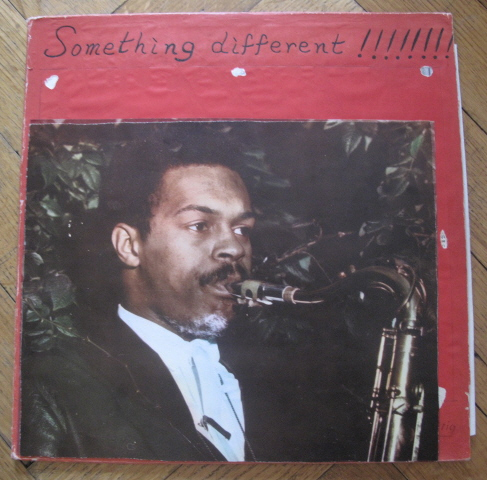 |
|
Two Critics Richard Koloda sent me a number of press cuttings recently, among which was the following review from The Sunday Times of 20th November, 1966 of Albert Ayler’s only appearance in the U.K. at the London School of Economics. |
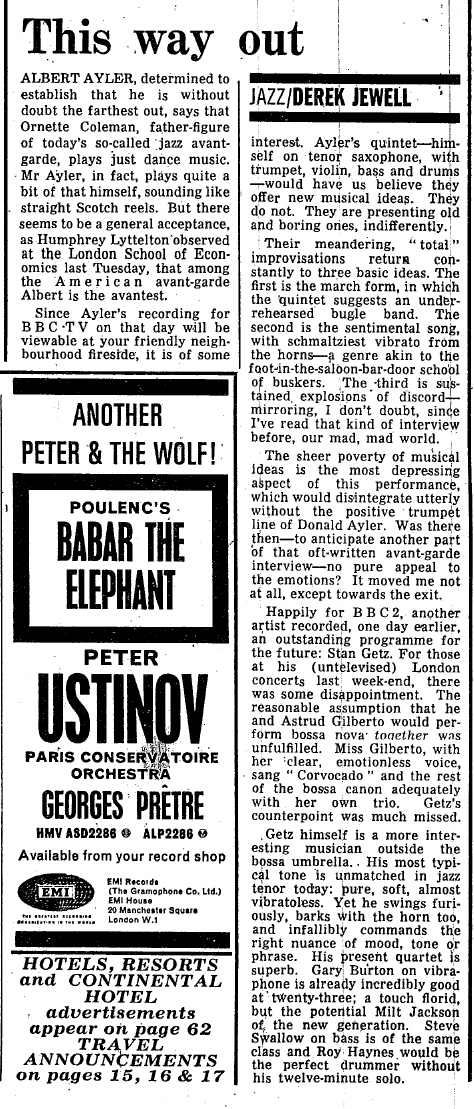 |
|
The polar opposite of Derek Jewell in terms of Ayler appreciation was the Cleveland journalist, Bernard Lairet, and Richard also sent me some of his articles about Albert, including an obituary, ‘The Holy Ghost Is Dead’, an article written on the first anniversary of his death, ‘Ayler: still unsung in his home town’, and a couple of pieces relating to the Ayler Memorial Concert held in Cleveland on 11th April, 1971. Richard also added this poignant coda in his email: *** Michael Anderson |
|
|
|
Bloody Hippies again Yair also found this page from The Buddhist Third Class Junkmail Oracle from February, 1968 which includes an ESP advert. Click the picture for the mind-blowing readable version. |
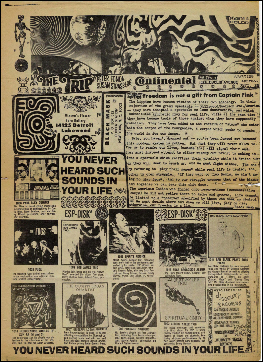 |
|
If you want more, the complete issue is available here. So that’s what was happening in Cleveland, Ohio. Meanwhile back in jolly old England, according to Drowned In Sound Sir Paul McCartney was cementing his reputation as the most far out of The Beatles: “He was the first one who screened all 485 minutes of Warhol’s Empire for almost all of London's art-elite of the time (and in his front room, to the accompaniment of a continuously rotated Albert Ayler album, with the artist himself in attendance to boot).” Maybe we should all try that one at home. *** What’s New, January to May 2012 has now been archived. *** July 1 2012 Titans of the Tenor! Unfortunately, not news of the whereabouts of the tape, but here’s the poster (click it for the bigger one). |
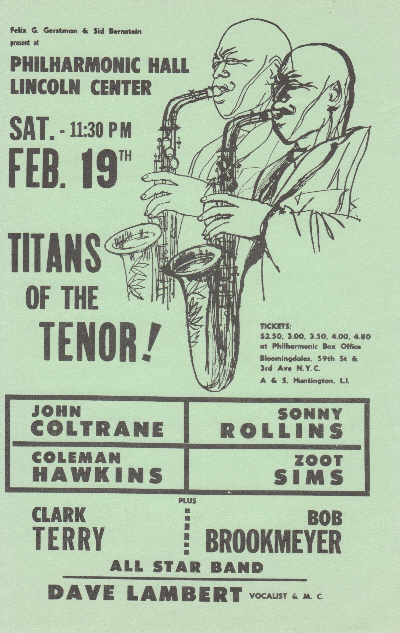 |
|
The handbill is for sale on the RecordMecca site, so if you’ve got an odd $900 lying around you can stick it in your cart. In the description, there’s this quote from Michael Cuscuna: “I had a front row seat. Coleman Hawkins was in great form with his quartet and Zoot Sims, backed by Roger Kellaway, was absolutely incandescent that night. Half way through Sonny Rollins’s set, Yusef Lateef slipped onto the stage with tenor in hand. The closer was shocking as the audience was expecting the classic Coltrane quartet. Instead out came Alice Coltrane, Jimmy Garrison and Rashied Ali and an army of horns including Don and Albert Ayler who stood at the edge of the stage and exploded into turbulent sound. I, for one, was pinned to my chair in utter confusion.” This legendary concert, the only known recording of John Coltrane with Albert Ayler (and a recording does exist, in the possession of Ravi Coltrane, but has never been released), was also described by Gary Giddins in a 2002 interview: “I went to the legendary concert called “The Titans of the Tenor” on February 19, 1966. I will never forget that evening for as long as I live. It was a Saturday night at Philharmonic Hall, which had one of the worst acoustic set-ups of any major concert hall. It was later destroyed and turned into Avery Fisher Hall. I believe the concert started at midnight. The advertised saxophonists were Zoot Sims, Coleman Hawkins, Sonny Rollins and John Coltrane. Even though the concert was called “Titans of the Tenor,” the producer for some reason also stuck in the Clark Terry and Bob Brookmeyer Quintet. I don’t know what that was about. Zoot and Hawkins did their bit, Sonny played thirty minutes during which he brought out unannounced guest Yusef Lateef. The first set was terrific. The second set was going to be Coltrane, and the emcee Dave Lambert said Rollins would come back to play with Coltrane. So, we were all sitting there expecting to see Jimmy Garrison, Elvin Jones, and McCoy Tyner. Instead, a dozen guys walk out there, with Garrison being the only one from the Quartet. He had two drummers, Rashied Ali and J.C. Moses, we didn’t know about that. Interstellar Space wasn’t released for years after that. Alice Coltrane was on piano, and nobody knew about her, at least us kids. We only knew of the records. We knew when you went to Sam Goody and bought the new John Coltrane record, we thought that was what was going on. So, he comes out with all these people - the Ayler Brothers…Man! To this day, I don’t think I will ever go into shock the way I did that day. Dan Morgenstern was there, and we talk about it and still joke about it. Dan just hated it. He was so offended and thought it was insulting to the other musicians. But, me, I was about 18 years old at the time. I was with my girlfriend and we turned to each other afterwards, and we both decided we loved it but were a little ashamed of loving it because we couldn’t explain it. We weren’t even completely sure it was music, but we felt invigorated. It was thrilling. There was a guy in a wheelchair holding up a brown paper bag, obviously a bottle in it. We had fifth or sixth row seats, near the center aisle, and he wheels up right up to that row, and Coltrane and the whole group got into some kind of rhythmic thing, and this guy started chanting. He was holding the brown paper bag like in a power fist, over his head, and he starts chanting, “Coltrane, Coltrane, Coltrane.” It was perfectly within the time and nobody was upset because it sounded like he was a member of the band!” The rest of that interview is on the Jerry Jazz Musician site, and Gary Giddins expanded on his reactions to the concert in his chapter of The Show I’ll Never Forget : 50 writers relive their most memorable concertgoing experience edited by Sean Manning (Da Capo Press, 2007): “... John Coltrane was one of five wind players who took the stage, including two more tenor titans (though at that time, you could have been punched out for claiming any such distinction for them), Albert Ayler—recognizable by a white lightning streak in his beard—and Pharoah Sanders; altoist Carlos Ward; and Albert’s troubled brother, trumpeter Donald Ayler. Here is where Morgenstern and I part on every detail. He concluded, “It was not unlike watching Joe Louis wrestle.” I felt like a kid at the circus. *** 13 Miniatures for Albert Ayler |
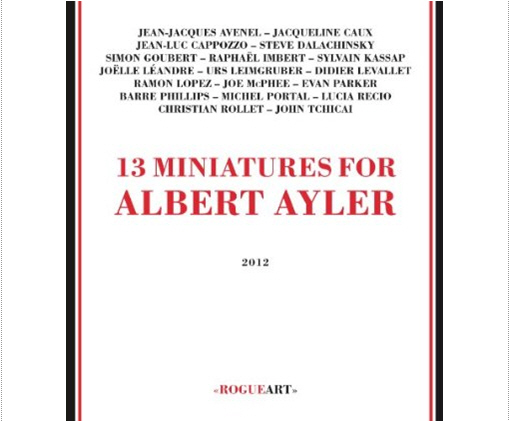 |
|
A new CD on the French RogueArt label, featuring 13 tracks recorded on 2nd December, 2010 at the Fondation Cartier in Paris, at the concert held to commemorate the 40th anniversary of Albert Ayler’s death. The featured artists are: 01. Jacqueline Caux (3:57) And here’s a bit of blurb from the sleevenotes by Philippe Carles: ‘Would it be that when everything finishes that everything starts? Rather than a postlude or a coda, the five minutes a cappella by Joe McPhee on the tenor saxophone placed here in thirteenth position, sound like a song of love and hope coloured utopia which condenses the invisibility of lives which are here and then are no longer here from the effervescence of an aviary where chirpings and warbling intersect (from Raphael Imbert, Urs Leimgruber, McPhee, Evan Parker and John Tchicai each sax seeming to seek its place in the mosaic puzzle of the memory) to promising flighty duels, then to a fine line drawn trio – of shivering brass (Cappozo), woody reed (Kassap) and simmering percussion (Rollet) – progressively repeating – pounding towards an exacerbation of a growling or a gentle explosion, a prelude to a dance of words like as many sparks (Dalachinsky) roped together con arco and solemn pizzicatos (Léandres, Phillips). Thundering alternations of the funeral echoes of the talking drums of Ramon Lopez and the deep melodies of a Portal who from 1976 (in Chateauvallon) paid homage to aylerian Angels – placed here, the trio of the basque musician with Lopez and Phillips seems to preface the outburst of husky lyricism of his instrumental counterpart (Avenel-Mcphee-Goubert ), then, as if to underline McPhee’s multi- instrumental expertise, the latter was to engage with Cappozzo in a gay dialogue of trumpeters, a mixture of muffled pistons, effects of breathing and brass tirades with scents of a mini-fanfare. Logically it’s a sort of “duo” that follows: a dialogue with himself, by the saxophonist Evan Parker by means of the virtuosity of circular breathing permitting as always this fascinating diphonism. As for the penultimate phases of this polyphonic hirsutism, fortified by explosions, whirlwinds, chants, howls, bubblings and very high pitched sounds, everything happens as if the last cry recalled, as in a trance, a certain aylerien spirit – did not Robert Schumann write “Music is what permits us to speak with the heavens”.’ *** Marc-Édouard Nabe And almost seamlessly we move to a Philippe Carles interview with Marc-Edouard Nabe on the subject of Albert Ayler from October, 1990. *** Paolo Botti Then straight on to Paolo Botti s myspace page which has four tracks from his Ayler tribute CD, Angels and Ghosts, including ‘Angels’ and ‘Ghosts’, as well as ‘Truth Is Marching In’ and ‘Nobody Knows The Trouble I’ve Seen’ performed on viola, banjo and dobro. *** Henry Grimes And finally, news of a forthcoming film about Henry Grimes from the Kickstarter site. The Life and Death and Life of Henry Grimes is a documentary project by Hank Cherry, and according to the site, funding has been raised and, judging by the short clip on there, filming has already begun. * And finally, thanks to Yair Dagan who dug up all of this stuff, apart from the 13 Miniatures, for which I used my own little internet shovel. *** August 1 2012 Let’s Sing For Him (A March for Albert Ayler) - the long version On 7th December 1970, just twelve days after the discovery of Albert Ayler’s body in the East River, John Stevens organised the musicians at the Baden-Baden Free Jazz Meeting and performed a tribute to Ayler entitled ‘Let’s Sing For Him (A March in Memory of Albert Ayler)’ (available on this site). What I didn’t know (until Yair Dagan told me) was that Stevens recorded a much longer version of the piece on 7th May 1971 at the Notre Dame Hall in London, which was released on CD in 1993. |
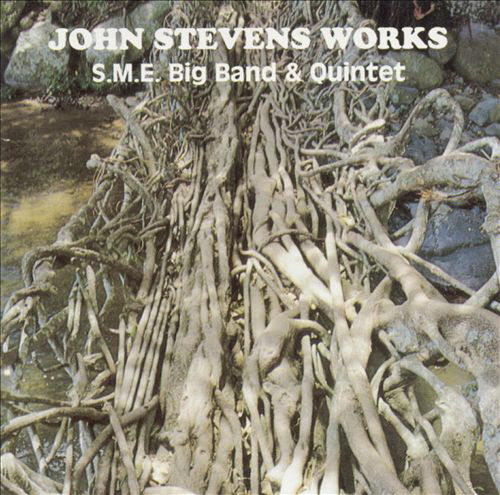 |
|
Full details and a review are available on the allmusic site and the 21 minute track is also available on youtube. * Black Lion mp3s Things were a lot simpler in the olden days when I started this site. I used to do a monthly update of which Ayler CDs were available at a number of internet stores, but then things got complicated. Stores closed down, Amazon started its marketplace, mp3s became the in thing, pirates ruled the waves. Now, if you’re willing to don the eyepatch and parrot, everything Ayler recorded can be found somewhere, but for those seeking legitimate downloads I thought I should mention that the four CDs released on the Black Lion label, My Name Is Albert Ayler, Witches and Devils, Goin’ Home, and Ghosts (aka Vibrations) are now available on mp3 from amazon.com (though not co.uk). Details of these early Ayler works (only one of which, Witches and Devils, seems to be available on CD - shame) can be found on the 1201music site, along with the rest of the Black Lion catalogue. * Poems I thought I should add a section to the Bibliography to account for all the odd poems about Ayler which are scattered around in books, magazines, websites, youtube and the rest. It’s by no means complete, but I will add things as I find them. One sad thing that I came across concerns The Magic Poetry Band, whose CD I mentioned last December since it contained a tribute to Albert Ayler. The performer of that poem and saxophonist with the band, Faruq Z Bey, died at the beginning of June, aged 70. There’s a new video/slideshow accompanying the track on youtube, but rather than embed it here, I thought it better to just add a link to the page since it includes more information about Faruq Z. Bey and some links to other items. There’s also an obituary on the Detroit metrotimes site. * Instead I thought I’d put this here, Dean Bowman and L. Bardaine plus children’s chorus (I know, you’re going to skip it, but don’t), performing “Here Is To You Albert Ayler” at the Banlieues Bleues festival in France on 21st March 2007.
|
|
And, if that’s too sweet and you fancy a bit of Ayler played on the baritone sax, here’s the Tongues of Fire Trio rendering ‘New Ghosts’ at the Brewhouse Arts Centre, Taunton on 8th July 2007 (with what I choose to believe is a subtle nod to New York Eye and Ear Control).
|
|
Jimmy Lyons Another Yair Dagan find, and although there’s not a lot of Ayler content in this one, I’m glad he passed it along. Jan Ström, founder of Ayler Records, and a useful source of information in the early days of this site, has a great site: Jimmy Lyons - A Sessionography The Ayler material, of course, is limited to his association with Cecil Taylor in the first part of the sessionography but there’s a wealth of other information on the site, some wonderful photos and a great video of the Cecil Taylor Quartet in Paris in 1966. Plus, as a bonus, there’s a picture of Jan Ström on the home page - nice to put a face to the name after all these years. * Happy 76th The all about jazz site named Albert its Jazz Musician of the Day on July 13th - which I think it does every year, but if you click on the ‘read more’ link it’ll take you to their Ayler page which, along with a few photos and a biography, has a list of all the reviews and articles about Ayler on the site. And congratulations to Sean Wilkie who managed to get the BBC’s regular Saturday evening programme, ‘Jazz Record Requests’ to play the first ‘Ghosts’ from Spiritual Unity on Saturday, 14th July. More than I could ever get them to do. He deserves a tankard. |
|
|
||||||||||||||||
|
*** September 1 2012 Sheherazade I must thank Roy Morris (of Homeboy Music) for sending me this review from the January 1965 edition of Jazz Monthly of the Albert Ayler Quartet at the Sheherazade Club in Amsterdam on 6th November 1964. I think we get so used to reading new reviews and articles about Ayler that we tend to forget how his music must have sounded to people nearly fifty years ago. I think this review, by Michael James, really captures that ‘shock of the new’. I’ve placed it in the Concert Reviews section of the Archives, but if you click the picture below you’ll get a readable version. |
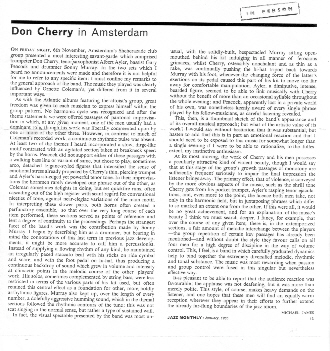 |
|
And although it’s not from Jazz Monthly, here’s a photo of the band at the Sheherazade in November 1964. |
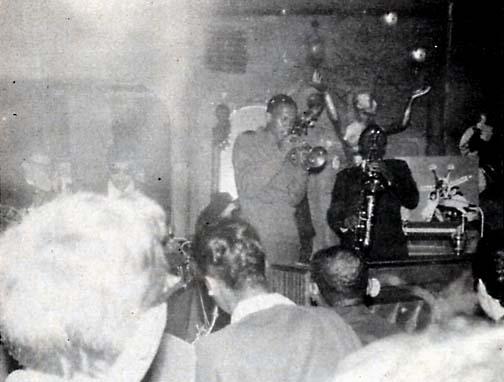 |
|
Inside Out In The Open And here’s a photo (which Richard Koloda came across) of Don Ayler and his father, Edward, at a screening of Alan Roth’s documentary about Free Jazz, Inside Out In The Open, at the Cleveland Cinematheque on 16th November, 2001. |
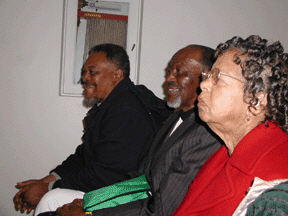 |
|
Rehearsal, Tributes and a Dance These are all from youtube. First, the dance - a short montage from the 1986 Karole Armitage ballet, The Elizabethan Phrasing of the Late Albert Ayler, which I’ve had listed on the Tributes page for years, so it’s nice now to see a bit of it.
|
|
Then there’s a rather long (36 mins) compilation of video and photos of the rehearsal for the performance of Alan Silva’s ‘Bells of Sant’ Anna’, which was performed in August 2010 at the Sant’ Anna Arresi Jazz Festival in Sardinia, which was dedicated that year to ‘The Holy Ghost and the Infinite Spirit of Albert Ayler’.
|
|
There’s also a tribute to Albert by trumpeter Demian Richardson and his band, recorded on 13th July this year. But, my particular favourite, is this performance by New Zealand band, The Spoilers of Utopia, of ‘The Truth Is Marching In’ at the Auckland War Museum on ANZAC day (25th April) this year. Check out the experimental camera work.
|
|
*** October 1 2012 The First Recordings Volume 3? Mats Gustafsson wrote to clear up one of those little mysteries of the Ayler discography - the existence of a third volume of The First Recordings. My summing up of the situation ran as follows: “The Jeff Schwartz biography lists 4 more titles - 2 alternate takes of ‘Softly As In A Morning Sunrise’, ‘Lover Man’ and ‘Everything Happens To Me’ - and credits ‘Raben 1989’ for the discographical information. The Mike Hames 1983 discography does not mention a third volume. According to Jan Strom of Ayler Records in Sweden, Bengt Nordström (the producer of the session) told him that everything that was recorded had been issued on Volumes 1 and 2.” This has now been confirmed by Mats, who wrote: Mats also said that the original versions of Volume 2 and 3 only existed as test pressings, between 5 and 10 of each. And that he’d also heard of a Japanese package which included all three volumes, although he couldn’t confirm that. So, thanks to Mats, and I should leave it there, but I did start to wonder who owned the rights to The First Recordings and whether there was any possibility of a single CD version of the entire session, since the running time is just 71 minutes. Although Volume 1 has been issued on a Sonet CD, this hasn’t been available since this site went online and Volume 2 has only been available as an expensive Japanese import on the DIW label. At which point I realised that The First Recordings (under its various names and volumes) was recorded in October 1962 and, as such, should soon be out of copyright. The one thing I thought I knew about copyright law was the 50 year rule regarding recordings. Turns out I was wrong. There have been a number of jazz recordings from the late 50s turning up on amazon in either nice 4 LP packages by Avid, or strange, just chuck 8 old LPs in a box, versions and I assumed this would continue. However, thanks to Sir Cliff Richard, the law was changed last year in Britain to bring it into line with Europe and the copyright on recordings has now been extended to 70 years. Apparently a similar change in the law was effected in America a while ago by the late Sonny Bono, and there the copyright lasts for 95 years. So, I guess the likes of Avid and the ‘chuck’em in a box’ companies will soon cease their activities. There’s a short article from September last year on *** And I’m afraid that’s about it for this month. The dearth of new Ayler material is epitomised by this (I wouldn’t bother, there aren’t even any walking women to spoil the minimalist mood). And all I got round to adding to the site is an article from The Village Voice of August 7th 1978, prompted by the release of The Village Concerts, entitled ‘Albert Ayler as Angel of History’ by Richard Mortifoglio. *** November 1 2012 News John Tchicai 28/4/1936 - 8/10/2012 |
|
|
|
More information about John Tchicai is available on his website where you’ll find the full interview. Among the obituaries, John Fordham’s in One of my favourite jazz LPs is John Tchicai’s Cadentia Nova Danica from 1968 - currently unavailable, of course - but the three tracks from Side 1 are on the Destination Out site. If you’ve never heard it, I suggest you give ‘Inside Thule’ a try - a gloriously unique sound. There are a number of video clips on youtube of John Tchicai, but I like this one, especially since there’s a nod in there to Ayler.
|
|
David S. Ware (7/11/1949 - 18/10/2012) Although there’s no direct connection to Albert Ayler, I feel I can’t move on without mentioning the loss of another great saxophonist, David S. Ware. Again, there are obituaries in The Guardian and The New York Times and further information on the official website, which includes a link to a short film, David S. Ware - A World of Sound (by Amine Kouider, funded by the David Lynch Foundation). And for the next four days the BBC Radio 3 site has the 90 minute programme, A Tribute to David S. Ware available online. * Paul McCartney and Albert Ayler - again And talking of the BBC - a brief snatch of Albert Ayler was played on primetime, Saturday night television the other week as part of a programme celebrating the 45th anniversary of the Beatles’ Magical Mystery Tour. Broadcast on BBC2 on 6th October, Arena: the Beatles’ Magical Mystery Tour Revisited included a short segment where Paul McCartney describes an experimental film he made in France with a soundtrack of Ayler playing La Marseillaise. However, since I was never a big Beatles’ fan, I didn’t watch it. Luckily, my friend, Clive Buttle did, and what’s more he had the technology to provide me with the relevant clip. Unfortunately youtube won’t touch it, so the link below will have to suffice: Paul McCartney and Albert Ayler * Michael Snow - again And talking of experimental films and harking back to New York Eye and Ear Control, Yair Dagan (glad you’re back) let me know about another film about Michael Snow which is available on vimeo. Michael Snow Up Close is a 45 minute documentary by Jim Shedden and Alexa-Frances Shaw, made in 1994 to document the Michael Snow Project at the Art Gallery of Ontario. Although there are lots of walking women and clips from some of Snow’s films, there’s no mention of Albert Ayler, and nothing from New York Eye and Ear Control, but it’s still worth a watch. Although, if you do get a bit fed up with the artiness of it all and wish to remain on the vimeo site, might I suggest this as a suitable antidote. * Dance Diaspora Ideally, this would come with a video, but so far all we have is a review. The Father, The Son, and The Holy Ghost: Albert Ayler was performed at Oberlin College on 12th and 13th October, 2012. The concluding part of a trilogy (the first two devoted to Eric Dolphy and John Coltrane), performed by Dance Diaspora and Essence, choreographed by Adenike Sharpley: “Ayler’s music provided the soundscape for the dance concert’s highlighted form, black expressionist dance, which Sharpley describes as “a form that does not concentrate on long lines of the arms, such as in Western dance forms. Rather the focus of the dance is on the expression of feeling through movement. The dancers become part of the orchestra and their bodies are considered instruments. “What was seen in this show was the ‘emotional-movement’ and reaction of the dancer to the music,” says Sharpley. The shows featured Cleveland-based tenor saxophonist and flutist Al Rollins and the soprano saxophone and flute of Ralph Jones, director of African Heritage House, who also was the show’s musical director. They were joined by 2004 graduate Marion Parker on bass and students from the conservatory’s jazz program: saxophonists DeSean Jones, a senior, and Malachi Thomas, a junior; first-year bassist Christopher Freedman, drummers Zaire Darden and Zane Rodulpho, both seniors; and pianist Shea Pierre, a junior.” * And finally ... A couple of tributes (spotted by Yair, as was the item above): To Albert Ayler in Memoriam by CC Music Composition (a bit too new-agey for me). And a new CD by The Whammies called The Music of Steve Lacy, which features tributes to various artists, including the third track, ‘The Wire (to Albert Ayler)’, which you can hear on the bandcamp site. |
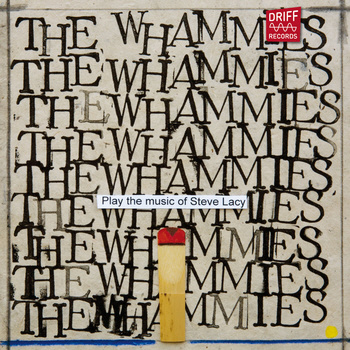 |
|
December 1 2012 Donald Ayler Sings Richard Koloda has been working on his biography of Albert Ayler for a number of years now and I’m happy to report it’s nearing completion. Back in October 2001 Richard filmed an interview with Don Ayler and his father, Edward, in Cleveland. During the interview, on a couple of occasions, Don started singing. Now, with Richard’s permission, and through the technical expertise of Clive Buttle, I have managed to put the four minute clip on youtube. So, here it is:
|
|
|
|
Bernard Stepien Orchestra - A Very Ayler Christmas - the Tradition This year, we caught several people, usually non-musicians, who were convinced that Omega is the Alpha, Ghosts, Bells, and many others, all Albert Ayler compositions, were true Christmas Carols and even subconsciously started to sing them by the Christmas tree. Thus, don't miss one of the following dates: This year with the following band: * Grimes Times! And here’s another tradition, the Henry Grimes New Year’s Eve concert in New York. Details (thanks Margaret) as follows: “Monday, Dec. 31st (New Year's Eve), 2O12, 11 p.m: Marc Ribot’s Spiritual Unity, w/ Henry Grimes, Roy Campbell, Jr., & Chad Taylor, Albert Ayler’s “Bells” at Midnight, at the Stone, northwest corner of Ave. C & 2nd St., Manhattan (NYC), $4O includes traditional champagne toast at midnight (preceded by a special surprise show at 7 p.m. to be announced, separate admission charge), no phone, no advance ticket sales or reservations, so please be there early. Take the F train to 2nd Ave., use 1st Ave. exit, and walk east to Ave. C, or the M-9 or M-21 bus to the corner of Houston St. and Ave. C. * Lorrach/Paris 1966 Thanks to Marco Grossi, who let me know that he’d heard from Hat Hut Records that they’re planning to re-release Lörrach-Paris 1966 in January/February 2013. It’ll be good to have it back in the catalogue alongside Hat Hut’s Stockholm, Berlin 1966. * A Couple of CDs |
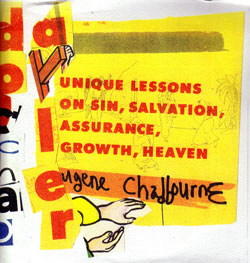 |
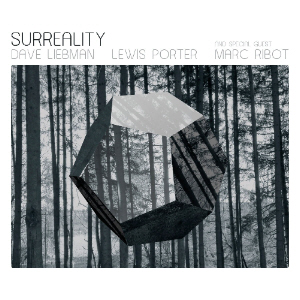 |
||
|
Now all the other items this month come from Yair Dagan - I thought the Don Ayler clip was enough and I could let the rest slide. First off, two new CDs which deserve a mention. The first is a double CD Ayler tribute album from Eugene Chadbourne - Doc Chad Ayler - which is available from the Squidco site. Here’s the blurb: “Doc Chad arranges and performs a vital section of the Albert Ayler songbook in a 2-CD release featuring solo settings to a quintet with musicians including Charles Tyler, Massimo Pupillo, Ted Reichman, Joe Williamson, &c. Ayler tunes covered include 4 versions of “Ghosts”, 2 of “Prophecy”, 2 of “Witches and Devils”, plus “Change Has Come”, “Truth Comes Marching In”, &c. Eugene Chadbourne is an extremely informed jazz historian, and his arrangements of these classic U.S. free jazz compositions represent a unique take on an important artist whose voice still resonates with modern improvised music. Recommended for all Ayler fans!” And here’s the tracklist: |
|
|
|
Personnel details and a few sound clips are available on the Squidco site. The other CD is Surreality by Dave Liebman and Lewis Porter, with special guest, Marc Ribot, and contains one Ayler-related track - ‘Omega is the Alpha/Ghosts’. There’s a review by John Fordham on The Guardian website. * Albert Ayler tribute mixtape thing This is a bit of a weird one - it’s a kind of Albert Ayler tribute mixtape thing, which runs for 2 hours, but there’s some interesting stuff on there. Probably best to let it run in the background while you get on with something else. * The Elizabethan Phrasing of the Late Albert Ayler I love the way this rather obscure, but wonderfully titled, ballet from 1986 keeps turning up. Back in September I mentioned a brief video had appeared on youtube (it should still be down below) and now Yair has unearthed these two items. The first is listed on the artvalue.com site as ‘Artwork for Albert Ayler Poster’ by David Salle, who designed the sets and costumes for the 1986 performance of The Elizabethan Phrasing of the Late Albert Ayler. Considering the little picture in the top right-hand corner of every page on this site, I find it rather spooky. |
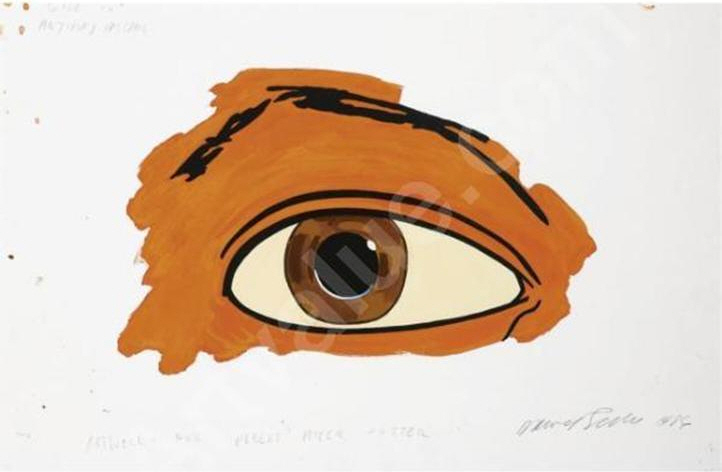 |
|||
|
And the other is this rather fetching photo of Karole Armitage, the choreographer of The Elizabethan Phrasing of the Late Albert Ayler. |
|||
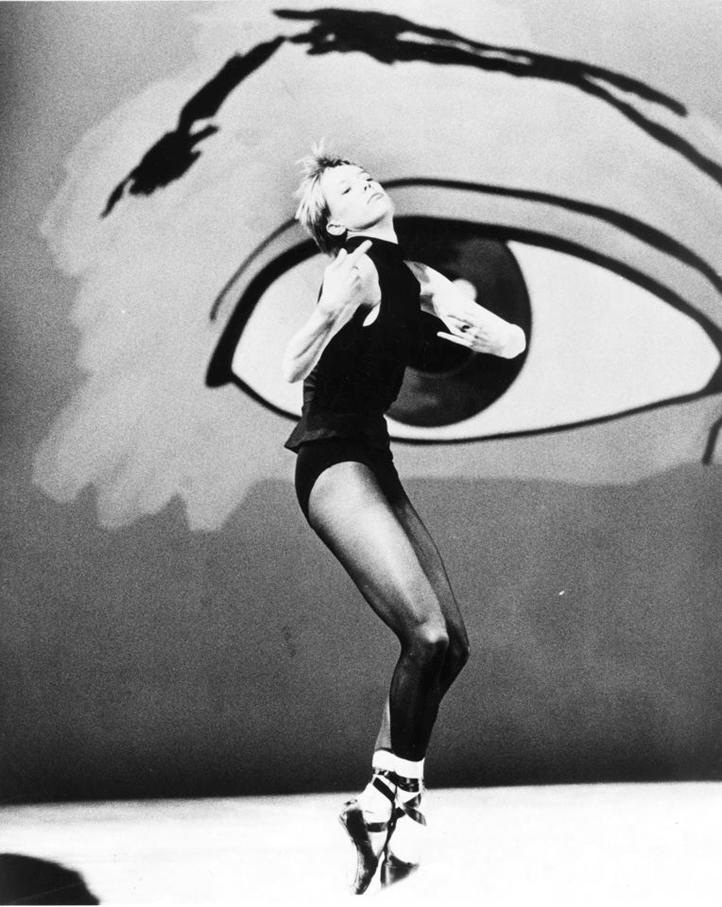 |
|||
|
And that’s it for another year. Thanks to all who’ve contributed to the site during the last 12 months, and all the very best for the festive season. Barring accidents (or major news stories) I’ll be back in 2013. *** December 18 2012 A Very Ayler Christmas - update Just a quick update. Bernard Stepien sent me a link to an mp3 of his first Ayler Christmas concert this year (details below). It was recorded and mixed by Matt Rogalsky / Memory Device, Kingston, Ontario, Canada. So many thanks to him and to Bernard, and a Joyeux Noël to one and all. *** News from 2004 (January - June) 2004 (July - December) 2005 (January - May) 2005 (June - December) 2010 (January - June) 2010 (July - December) 2011 (January - May) 2011 (June - September) 2011 (October - December) 2012 (January - May) 2013 (January - June) 2013 (July - September) 2013 (October - December) 2014 (January - June) 2014 (July - December) 2015 (January - May) 2015 (June - August) 2015 (September - December) 2016 (January - March) 2016 (April - June) 2016 (July - August) 2016 (September - December) 2017 (January - May) 2017 (June - September) 2017 (October - December) 2018 (January - May) 2018 (June - September) 2018 (October - December) 2019 (January - May) 2019 (June - September) 2019 (October - December) 2020 (January - April) 2020 (May - August) 2020 (September - December) 2021 (January - March) 2021 (April - July) 2021 (August - December) 2022 (January - April) 2022 (May - August) 2022 (September - December) 2023 (January - March) 2023 (April - June) 2023 (July - September) 2023 (October - December) 2024 (January - March) 2024 (April - June) 2024 (July - September) 2024 (October - December) 2025 (January - March)
|
|||
|
Home Biography Discography The Music Archives Links What’s New Site Search
|

